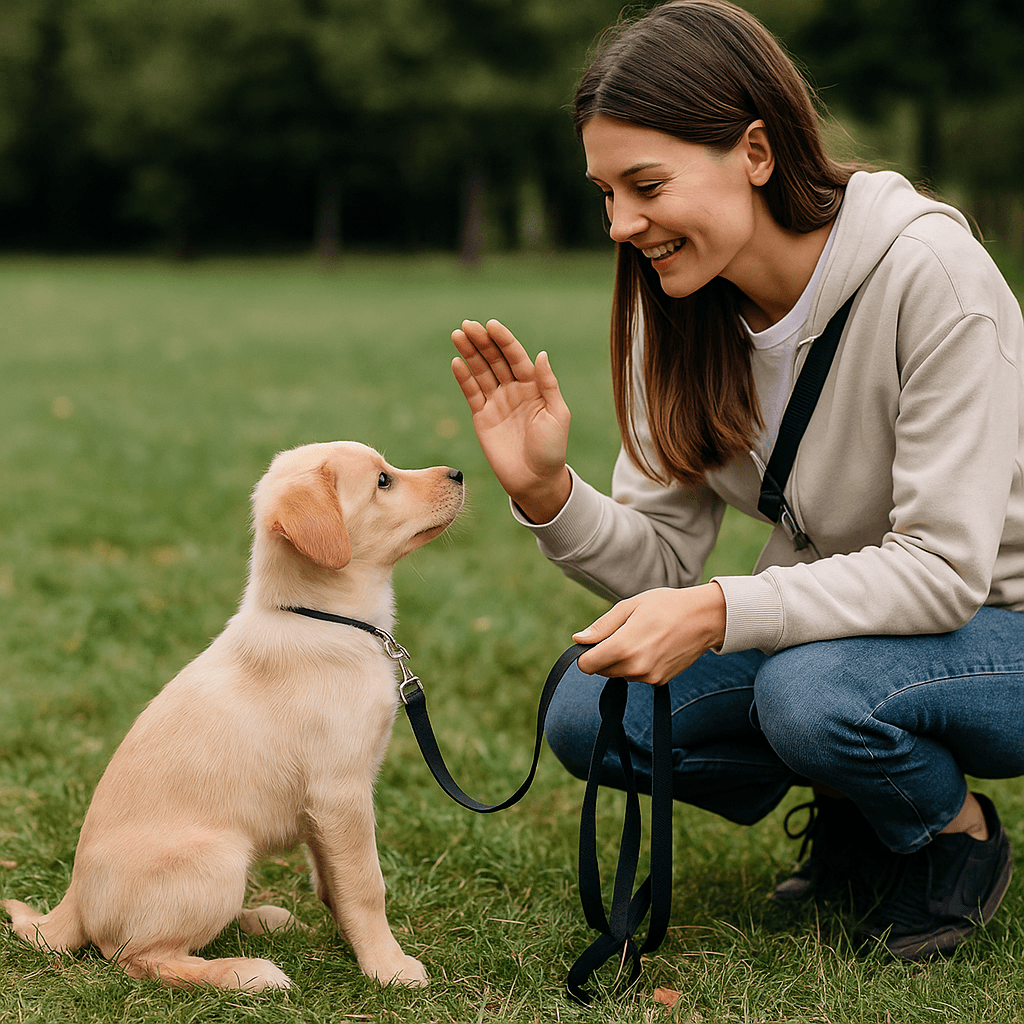
Dogs as surrogate children and best friends – what do scientists think?
Contents
-
Dogs as Children – a Growing Trend in Western Societies
-
Where does the strong bond between a dog and a human come from?
-
What does science say? Research on the human-dog relationship.
-
Why do we treat dogs like family members?
-
Pros and cons of "humanizing" dogs
-
Dogs, childlessness and demographic changes
-
Can a dog really replace a child?
-
FAQ – questions and answers
-
Summary

1. Dogs as Children – a Growing Trend in Western Societies
In recent decades, the role of a dog in the family has changed dramatically. Today, for many people, a dog is not just a companion animal—it's a full-fledged member of the family, often treated almost like a child.
-
More and more people are choosing to have a dog instead of a child or before deciding to have children.
-
Lifestyles are changing: dog owners are organizing birthday parties for their dogs, buying clothes, and using premium grooming services.
-
The growing popularity of dog hotels, dog kindergartens and luxury products demonstrates a change in perception.
This phenomenon is particularly evident in large cities and developed countries, where dogs are increasingly receiving the same rights and privileges as humans. It's no longer surprising to see dogs traveling in special strollers, eating hand-prepared meals, or sleeping in their owners' beds.
Moreover, the pet industry is dynamically responding to this trend:
-
Development of the premium segment: designer beds, cosmetics, clothes.
-
Specialized services: photo sessions, spas, animal psychologists.
-
Marketing campaigns from major brands treating dogs as "new family members."
Social psychologists point out that in today's world, a dog often plays the role not only of a companion, but also of an emotional substitute – someone who provides unconditional love in times of increasing individualism and isolation.
2. Where does the strong bond between a dog and a human come from?
The bond between dog and human is the result of thousands of years of shared evolution, but its depth and intensity are the subject of numerous scientific studies.
🧠 The Neurobiology of Attachment: Oxytocin and Gaze
A study published in the journal Science found that when dogs and their owners look into each other's eyes, their levels of oxytocin, a hormone responsible for creating social bonds, similar to the mother-child relationship, increase.
Additionally, interactions with a dog, such as petting, can lower cortisol (a stress hormone) levels in the owner, according to research published in Frontiers in Psychology .
🧬 Evolutionary Foundations of Relationships
Dogs were domesticated over 15,000 years ago, meaning they have co-evolved with humans for millennia. Living together and cooperating has led to dogs' unique ability to read human emotions and social cues. Studies have shown that dogs can distinguish human facial expressions and respond appropriately, demonstrating their advanced empathy and communication skills.
🤝 Psychological aspects of bonding
From a psychological perspective, the relationship between a dog and a human is similar to that between a parent and a child. Dogs exhibit attachment behaviors, such as seeking closeness, anxiety during separation, and joy at reunion. Such behaviors are characteristic of strong emotional bonds and demonstrate the deep attachment dogs feel to their owners.
3. What does science say? Research on the human-dog relationship
The relationship between humans and dogs fascinates scientists worldwide. Research indicates that this bond is not accidental—it has deep neurobiological and evolutionary foundations.
📚 Scientific discoveries: dogs and human emotions
Research published in Scientific Reports proves that interaction with a dog activates the same areas of the human brain responsible for bonding and caring as the parent-child relationship ( nature.com ):
-
Petting a dog increases oxytocin – the hormone responsible for building trust and closeness.
-
Contact with a dog lowers cortisol levels, which results in reduced stress and improved well-being.
-
Dogs trigger natural caregiving mechanisms in humans, strengthening emotional attachment.
🧬 Interspecies bond – why is it so strong?
-
Dogs have evolved alongside humans for over 15,000 years, learning to interpret human emotions and intentions.
-
Research shows that dogs respond to human smiles, sadness, and even micro-expressions.
-
This unique emotional synchrony makes the human-dog bond one of the deepest in the natural world.
Source: Scientific Reports – Human-Pet Bonding Study
🎯 The impact of a dog on human mental health
-
Owning a dog reduces the risk of depression, anxiety and loneliness.
-
Dogs support the treatment of PTSD, depression, and even chronic diseases through their therapeutic effect.
-
Regular contact with a dog improves daily motivation, lowers blood pressure and increases resistance to stress.
Source: Therapy Dogs International
4. Why do we treat dogs as family members?
In the 21st century, the relationship between humans and dogs increasingly resembles that of a close family member—not just a companion animal. This process is the result of a series of social, economic, and psychological changes.
📈 Key reasons for changing your dog's role
-
Demographic changes – the growing number of singles, childless couples and patchwork families means that a dog fills an emotional void and becomes a full-fledged life companion.
-
Increased prosperity – higher incomes enable investment in animal comfort, health and entertainment on an unprecedented scale.
-
Changing social values – in a world where the durability of human relationships is decreasing, dogs offer unconditional acceptance, loyalty and emotional closeness.
-
Influence of media and marketing – advertising campaigns, films and social media portray dogs as “children” or “family members”, reinforcing this cultural phenomenon.
🧠 Psychological Aspects of Humanizing Dogs
Research shows that treating a dog like a family member brings real psychological benefits to people:
-
Reduces stress and anxiety levels.
-
Strengthens the sense of meaning in everyday life.
-
Increases the level of happiness and life satisfaction.
Source: Frontiers in Veterinary Science – Human-Animal Bond
5. Pros and cons of "humanizing" dogs
Treating your dog as a family member brings many benefits, but also certain risks that are worth knowing in order to consciously build a healthy relationship with your pet.
✅ Advantages of humanizing dogs
-
Stronger emotional bond – daily contact, rituals, tenderness and care create a deep relationship based on mutual trust.
-
Greater attention to the dog's well-being – caregivers take the dog's needs more seriously, ensuring its health, proper diet and comfort of life.
-
Better understanding of an animal's emotions – humanization teaches empathy and makes you more sensitive to the signals your dog sends.
-
Improving the mental health of the owner – contact with a dog reduces stress, improves mood and increases happiness.
❌ The downsides of over-humanizing dogs
-
Misinterpreting a dog's signals – attributing human emotions to an animal can lead to misunderstandings and inappropriate reactions.
-
Satisfying your own needs at the expense of your dog – treating your dog like a child can limit its natural needs (exercise, exploration, social contact).
-
Behavioral problems – overprotectiveness can lead to separation anxiety, frustration or aggression.
-
Imbalance in the relationship – the dog is unable to meet all the emotional expectations of the owner, which can lead to mutual frustration.
📚 Worth knowing:
Over-humanizing dogs is one of the main factors leading to behavioral disorders – according to a study published in the Journal of Veterinary Behavior , dogs treated in an over-protective manner show higher levels of stress and more frequent adaptation problems.
Source: Journal of Veterinary Behavior
6. Dogs, childlessness and demographic changes
📉 Demographic changes in Western societies
Over the past few decades, many developed countries have seen a noticeable decline in birth rates. The rise in singles and couples consciously choosing to live without children is driving changes in family structures. In response to these changes, dogs are beginning to serve as emotional substitutes for children, becoming not only life companions but also objects of care, concern, and affection.
🐕 Dogs as "children" in modern families
For many people, a dog becomes an important part of family life. Instead of having children, some couples choose to adopt a dog, treating it like a member of the family. Dogs are given human names, celebrated birthdays, and even given gifts. In some cases, the dog is treated as a full-fledged member of the family, with owners devoting significant time and attention to it, similar to the approach to raising children.
📊 Increase in the number of single-person households
Modern societies are also characterized by an increase in the number of people living alone. Single people are increasingly choosing to adopt a dog to fill an emotional void. In such cases, a dog becomes not only a companion but also a source of emotional support. The growing number of such households influences the perception of dogs as ideal partners for single life.
💡 Dogs as Life Companions in the Age of Childlessness
-
Emotional void : In the face of childlessness, dogs become an alternative for people who seek a sense of closeness, unconditional love and emotional support.
-
Increased quality of life : Many studies show that contact with a dog has a positive impact on people's well-being, improving mood and reducing feelings of loneliness.
-
Increased spending on pets : Demographic changes are leading to increased spending on dogs – they are starting to benefit from luxury services such as spas, hotels, veterinary medicine, and various accessories.
📚 Worth knowing:
Research conducted by the American Pet Products Association shows that over 70% of dog owners in the US consider their pets to be family members. This phenomenon is also growing in Europe, where dogs are increasingly replacing children in many families.
Source: American Pet Products Association
7. Can a dog really replace a child?
A dog can provide emotional support and companionship, but it cannot fully replace a child. While dogs fulfill many human needs, such as companionship, love, and a sense of purpose, they also have unique needs that differ from those associated with raising a child. There are many factors to consider when comparing these two relationships.
❤️ What can a dog offer its owner?
Dogs offer many positive aspects that attract people to this form of companionship:
-
Unconditional love – a dog loves its owner regardless of his mood, social status or life situation.
-
A sense of duty – owning a dog comes with responsibility, which can increase a sense of purpose and structure in daily life.
-
Emotional support – a dog helps reduce feelings of loneliness, stress and anxiety, which has been confirmed by numerous scientific studies.
⚠️ The differences between caring for a dog and raising a child
While dogs can fulfill many emotional functions, they don't fulfill all the roles that a child plays in a human's life. Here are the key differences:
-
Education and Development – A child requires education, developing life skills, and preparing for adulthood. A dog does not go through the same process. Dogs develop, but their need for education is limited to basic commands and training.
-
Communication Skills – A child can express their thoughts, feelings, and needs verbally. A dog communicates primarily through body language, barking, and other behavioral cues, which can lead to misunderstandings if the owner misinterprets the dog's behavior.
-
Long-term commitment – Raising a child is a long-term commitment to shaping a person who will become an independent adult. A dog doesn't reach this stage – it remains dependent on its owner for its entire life.
-
Life Cycle – Dogs have a much shorter lifespan than humans, which inevitably involves emotional distress for the animal. Children grow, develop, and become independent, whereas dogs do not go through this stage.
📚 What does the research say?
Research published in Anthrozoös shows that people who treat their dogs like children have strong emotional bonds, but they face challenges related to the unmet need for education, development, and communication that raising a child offers. Furthermore, a dog as a life companion can provide emotional support, but it cannot fulfill the role a child plays in its owner's life.
Source: Anthrozoös Journal
🐕 A dog as a support, but not as a child
While a dog can fulfill many emotional roles in a caregiver's life, it's important to remember that a dog and a child present two completely different challenges and needs. A dog can fill an emotional space, provide companionship, and provide a sense of security, but it can't offer the same benefits as a child, who continues to develop and transition throughout their life.
8. FAQ – questions and answers
In this section, we answer frequently asked questions about human-dog relationships, how dogs replace children, and how dogs serve as emotional companions in people's lives.
Does the dog feel like he is treated like a child?
Dogs are highly sensitive to our emotions, but they don't understand the concept of a "child." Instead, they respond to our behavior, tone of voice, and body language. While a dog may feel loved, treating them like a child isn't fully understood. From a dog's perspective, the most important things are daily rituals, care, and time spent with their caregiver.
-
Example : If we treat a dog like a child, expecting it to respond the same way we would to a human, we may encounter misunderstandings. For example, a dog may not understand why we are sad if we don't use appropriate communication methods.
Can a dog suffer from over-humanization?
Yes, over-protection and treating a dog like a child can lead to behavioral problems such as separation anxiety, frustration, or even aggression. Too much attachment to a caregiver and over-adaptation of a dog to the human rhythm of life can disrupt its natural balance. Dogs, like all animals, have needs that don't always align with human expectations.
-
Example : A dog treated like a child may become overly nervous or anxious when its owner is not around. It may also have difficulty socializing with other dogs if it is not accustomed to interacting with them.
Does a dog understand our emotions?
Yes, dogs are exceptionally capable of recognizing human emotions. Research shows they can read our moods based on facial expressions, tone of voice, and body language. Dogs perfectly understand when we are sad, happy, stressed, or anxious, and they can adapt their behavior to our emotions.
-
Example : We often see a dog comforting its owner by resting its head on their lap when they are sad. Similarly, a dog may happily wag its tail when its owner is in a good mood.
Can a dog replace a child in an emotional relationship?
A dog can fulfill certain emotional needs, but it cannot fully replace a child. Dogs offer unconditional love, companionship, and support, but they do not require the same education, nurturing, and development as a child. Dogs are excellent companions, but their role in the family differs from that of children.
-
Example : A dog provides a sense of security and companionship, but it doesn't have the same capacity for intellectual or emotional development as a human. Furthermore, a dog's lifespan is shorter, which presents various challenges in the relationship with a pet.
Why are dogs so important in the lives of childless people?
Modern society is becoming increasingly diverse, and the number of people living alone or choosing to live without children is growing. For many of these individuals, a dog becomes not only a companion but also a source of security, love, and emotional stability. It fills the emotional void that children could otherwise occupy.
-
Example : For a lonely person, a dog becomes a constant companion who provides a feeling of closeness, especially in moments when a person feels lonely or insecure.
9. Summary
Dogs have been companions of humans for centuries, but contemporary social, emotional, and cultural changes have meant that for many people, they have become more than just pets. Today, dogs are treated as full-fledged family members, acting as companions, surrogate children, and even primary sources of emotional support.
🐾 Unconditional love and emotional support
Dogs offer something other relationships can't: unconditional love. They give us a sense of security, joy, and fulfillment. In moments of sadness, stress, or loneliness, they are there for us, ready to offer comfort and stability. The emotional bond we experience with a dog is as strong as the bond with a family member.
🧠 The changing role of dogs in society
Dogs have become an integral part of many people's lives, and their role in the family is constantly evolving. For childless individuals, singles, childless couples, or the elderly, a dog can be not only a companion but also an emotional partner, filling the void often left by the absence of children. In such cases, a dog becomes more than just a pet—it becomes part of the family, enjoying similar rights and treated as a member.
❗ Humanizing Dogs – Benefits and Challenges
Over-humanizing dogs brings benefits, such as a stronger emotional bond, better care, and a greater understanding of the dog's needs. However, this approach also carries certain risks, including misinterpreting dog signals, behavioral issues, and satisfying one's own emotional needs at the animal's expense. Over-protectiveness can lead to problems such as separation anxiety and excessive dependence on the owner.
⚖️ Dog and child – differences in needs and roles
While a dog can fulfill many of a person's emotional needs, it cannot replace a child. A dog provides love and companionship, but its needs are different – it does not require education or development like humans. Dogs are our companions, but they do not go through the stages of childhood development, do not learn in the same way, and do not enter the stages of adulthood.
🧳 A future together – a dog as your best friend
A dog doesn't have to be our child to fill our lives with love, companionship, and joy. It's enough that they become our best friend. A dog gives us joy, support, loyalty, and a sense of purpose, but let's not forget that it's also an animal with needs—exercise, interaction with other dogs, responsible care, and respect for its nature.
A dog, even though it is not a human, can become a human's best companion, giving us everything that is most important in a relationship: love, trust, friendship and support.





 https://petto.com.pl
https://petto.com.pl